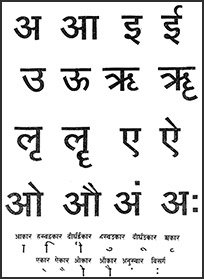Avadhi: 23 definitions
Introduction:
Avadhi means something in Hinduism, Sanskrit, Jainism, Prakrit, Buddhism, Pali, the history of ancient India, Marathi, Hindi. If you want to know the exact meaning, history, etymology or English translation of this term then check out the descriptions on this page. Add your comment or reference to a book if you want to contribute to this summary article.
Images (photo gallery)
In Hinduism
Dharmashastra (religious law)
Source: Wisdom Library: Dharma-śāstraAvadhi (अवधि) refers to the “remote”, as in, that which can be seen by the eyes of the Devas. It is used throughout Dharmaśāstra literature such as the Manusmṛti and the Baudhāyana-dharmasūtra.

Dharmashastra (धर्मशास्त्र, dharmaśāstra) contains the instructions (shastra) regarding religious conduct of livelihood (dharma), ceremonies, jurisprudence (study of law) and more. It is categorized as smriti, an important and authoritative selection of books dealing with the Hindu lifestyle.
Vyakarana (Sanskrit grammar)
Source: Wikisource: A dictionary of Sanskrit grammarAvadhi (अवधि).—Limit,which is either exclusive or inclusive of the particular rule or word which characterizes it: cf. सर्वश्च हल् तं तमवधिं प्रति अन्त्यो भवति (sarvaśca hal taṃ tamavadhiṃ prati antyo bhavati) M. Bh. on I.3.3.

Vyakarana (व्याकरण, vyākaraṇa) refers to Sanskrit grammar and represents one of the six additional sciences (vedanga) to be studied along with the Vedas. Vyakarana concerns itself with the rules of Sanskrit grammar and linguistic analysis in order to establish the correct context of words and sentences.
Shaktism (Shakta philosophy)
Source: Google Books: ManthanabhairavatantramAvadhi (अवधि) refers to the “end” (of the head), according to the Manthānabhairavatantra, a vast sprawling work that belongs to a corpus of Tantric texts concerned with the worship of the goddess Kubjikā.—According to the Ṭīkā the length of the body is eighty-four finger-spans up to the end of the head [i.e., mastaka-avadhi]. Beyond that is the place of the Triple Peak Mountain—Trikūṭa—that covers twelve fingers’ space and is the End of the Twelve. Together they cover a distance equivalent to the width of ninety-six fingers.

Shakta (शाक्त, śākta) or Shaktism (śāktism) represents a tradition of Hinduism where the Goddess (Devi) is revered and worshipped. Shakta literature includes a range of scriptures, including various Agamas and Tantras, although its roots may be traced back to the Vedas.
In Jainism
General definition (in Jainism)
Source: archive.org: TrisastisalakapurusacaritraAvadhi (अवधि) or Avadhijñāna refers to “clairvoyant knowledge of physical objects” and represents one of the five types of “right-knowledge” (samyagjñāna), as mentioned in chapter 1.3 [ādīśvara-caritra] of Hemacandra’s 11th century Triṣaṣṭiśalākāpuruṣacaritra: an ancient Sanskrit epic poem narrating the history and legends of sixty-three illustrious persons in Jainism. Accordingly, as mentioned in Ṛṣabha’s sermon:—“[...] mokṣa is attained by those who practice unceasingly the brilliant triad of knowledge, faith, and conduct. Among these, exact knowledge which comes from a summary or detailed study of the principles, jīva, etc., is called ‘right-knowledge’ (samyagjñāna). [...] Avadhi-jñāna is innate to gods and hell-inhabitants. Of others it is six-fold, characterized by destruction and suppression”.
Avadhi has six sub-divisions (cf. Tattvārthādhigamasūtra 1.23 with commentary):—
- anānugāmika, it is extinguished if they change place;
- ānugāmika, it is not extinguished;
- hīyamānaka, in some its sphere of influence is greatly diminished or it disappears completely;
- vardhamānaka, its sphere of influence increases greatly;
- anavasthita, in some cases it is fluctuating or intermittent;
- avasthita, constant and unfluctuating.
Avadhi (अवधि, “clairvoyance”) refers to one of the five types of knowledge (jñāna) , according to Tattvārthasūtra 1.9-10—What is meant by avadhi (clairvoyance)? The crisp knowledge of concrete objects/entities acquired, without the assistance of the mind and sensory organs but with the limitations of substance, modes, time and place is called clairvoyance.
How many types of clairvoyance (avadhi-jñāna) are there and what are their names? There are two main types of clairvoyance, namely: with state as the cause (bhava-pratyaya) and the spiritual purification by partial subsidence-cum-destruction of Karmas (guṇa-pratyaya) as the cause of clairvoyance.
How is clairvoyance (avadhi) classified in another manner? There are three other types of clairvoyance namely 1) deśa; 2) parama; 3) sarva. Who are the owners of these classes of clairvoyant knowledge? Generally clairvoyance is possible to be attained by the living beings in all the four destinies /states (gati). However the deśāvadhi can be attained by living beings in human and sub-human states with right faith. The other two types, namely parmāvadhi and sarvāvadhi, are possible only for the monks who are shortly going to attain liberation.
Source: Encyclopedia of Jainism: Tattvartha Sutra 3: The Lower and middle worldsAvadhi (अवधि, “clairvoyance”) refers to one of the eighteen types of extraordinary intellect (buddhi), which itself is a subclass of the eight ṛddhis (extraordinary powers). These powers can be obtained by the Ārya (civilized people) in order to produce worldly miracles. The Āryas represent one of the two classes of human beings according to the 2nd-century Tattvārthasūtra 3.46, the other being Mleccha (barbarians).
What is meant by extraordinary clairvoyance (avadhi-riddhi)? Owner of clairvoyant knowledge cognizesdirectly, the concrete objects within certain limitations of the time periods and distance and without the assistance of sense organs. It is of three types namely partial (deśa), all (sarva) and supreme (parama).
Avadhi (अवधि, “clairvoyance”) refers to one of the five divisions of Jñānāvaraṇa, or “knowledge obscuring (karmas)”, which represents one of the eight types of Prakṛti-bandha (species bondage): one of the four kinds of bondage (bandha) according to the 2nd-century Tattvārthasūtra chapter 8.—What is meant by clairvoyance obscuring karma (avadhi-āvaraṇa)? The karma which obstructs the full manifestation of the clairvoyance knowledge is called clairvoyance knowledge obscuring karma. Avadhi is also known as Avadhijñānāvaraṇa or Avadhijñānāvaraṇīya.
Source: JAINpedia: JainismAvadhi (अवधि) in Sanskrit (Ohi in Prakrit) refers to “clairvoyance” and represents one of the five types of knowledge, as explained in the Nandīsūtra.—The heart of the Nandī-sūtra deals with the concept of cognition or knowledge in its various divisions and subdivisions. This is also an appropriate topic for a text that transcends all categories in the Śvetāmbara canon, for it can be regarded as a prerequisite to the scriptures. First comes the list of the five types of knowledge [viz., avadhi, “clairvoyance”], known from other sources as well, such as the Tattvārtha-sūtra I. 9-33.
There are various types of clairvoyance (avadhi). When considered to relate to one’s own condition – bhava-pratyaya – it is manifested in gods and hell-beings. Humans and animals with five senses can achieve clairvoyance resulting from the ending and destruction of karmas – kṣayopaśama – from ascetic practices.

Jainism is an Indian religion of Dharma whose doctrine revolves around harmlessness (ahimsa) towards every living being. The two major branches (Digambara and Svetambara) of Jainism stimulate self-control (or, shramana, ‘self-reliance’) and spiritual development through a path of peace for the soul to progess to the ultimate goal.
India history and geography
Source: Cologne Digital Sanskrit Dictionaries: Indian Epigraphical GlossaryAvadhi.—cf. avadher = anantaram (LP), ‘after the time limit is over’. Note: avadhi is defined in the “Indian epigraphical glossary” as it can be found on ancient inscriptions commonly written in Sanskrit, Prakrit or Dravidian languages.
--- OR ---
Avadhī.—language of Avadh (Oudh). Note: avadhī is defined in the “Indian epigraphical glossary” as it can be found on ancient inscriptions commonly written in Sanskrit, Prakrit or Dravidian languages.

The history of India traces the identification of countries, villages, towns and other regions of India, as well as mythology, zoology, royal dynasties, rulers, tribes, local festivities and traditions and regional languages. Ancient India enjoyed religious freedom and encourages the path of Dharma, a concept common to Buddhism, Hinduism, and Jainism.
Languages of India and abroad
Pali-English dictionary
Source: BuddhaSasana: Concise Pali-English Dictionaryavadhi : (m.) boundary; limit.
Source: Sutta: The Pali Text Society's Pali-English DictionaryAvadhi, 3 sg. aor. of vadhati.—At DhA. II, 73 avadhi = odhi. (Page 83)

Pali is the language of the Tipiṭaka, which is the sacred canon of Theravāda Buddhism and contains much of the Buddha’s speech. Closeley related to Sanskrit, both languages are used interchangeably between religions.
Marathi-English dictionary
Source: DDSA: The Molesworth Marathi and English Dictionaryavadhi (अवधि).—m f (S) A limit or boundary; a point of time at which begins or ends any work or business; or a point or line of space marking and defining a thing or body. 2 Intermediate or intervening time or space; a term, period, interval, distance. 3 The standard or measure of a comparison: that than which a thing is affirmed to be greater or less, better or worse &c. 4 The starting post or the goal, the commencing or the terminating point (of a career or course). 5 Root, seat, parent; the stock from which a body is separated or an action proceeds. 6 Used as prep In comp. Until or up to. Ex. parjanyakālāvadhi, rā- tryavadhi, kālāvadhi, dēśāvadhi, dina-māsa-varṣa-avadhi; or (vulgarly) During or whilst; through the time of the continuance of.
Source: DDSA: The Aryabhusan school dictionary, Marathi-Englishavadhi (अवधि).—m f A limit or boundary. Interval.
Marathi is an Indo-European language having over 70 million native speakers people in (predominantly) Maharashtra India. Marathi, like many other Indo-Aryan languages, evolved from early forms of Prakrit, which itself is a subset of Sanskrit, one of the most ancient languages of the world.
Sanskrit dictionary
Source: DDSA: The practical Sanskrit-English dictionaryAvadhi (अवधि).—[ava-dhā-ki]
1) Application, attention.
2) Boundary, limit exclusive or inclusive, (in time or space); conclusion, determination; एकैकस्य जगत्त्रयप्रमथनत्राणाव- धिर्योग्यता (ekaikasya jagattrayapramathanatrāṇāva- dhiryogyatā) Mv.1.46; रवितेजसामवधिनाधिवेष्टितम् (ravitejasāmavadhinādhiveṣṭitam) Kirātārjunīya 12.22.
3) Furthest limit; दृष्ट आह्लादनीयानामवधिः (dṛṣṭa āhlādanīyānāmavadhiḥ) K.124; स्मरशापाव- धिदां सरस्वतीम् (smaraśāpāva- dhidāṃ sarasvatīm) Kumārasambhava 4.43; conclusion; oft. at the end of comp., in the sense of 'ending with', 'as far as', 'till'; एष ते जीवितावधिः प्रवादः (eṣa te jīvitāvadhiḥ pravādaḥ) Uttararāmacarita 1. तत्प्रत्यागमनकालावधयोऽपि तावत् ध्रियन्तां प्राणाः (tatpratyāgamanakālāvadhayo'pi tāvat dhriyantāṃ prāṇāḥ) K.171; व्याडी रक्षतु मे देहं ततः प्रत्यागमावधि (vyāḍī rakṣatu me dehaṃ tataḥ pratyāgamāvadhi) Kathāsaritsāgara 4.1; स्कन्धः स्यान्मूलाच्छाखावधिस्तरोः (skandhaḥ syānmūlācchākhāvadhistaroḥ) Ak.
4) Period of time, time; सर्वे निदाघावधिना प्रमृष्टाः (sarve nidāghāvadhinā pramṛṣṭāḥ) R.16.52; शेषान् मासान् विरहदिवसस्थापितस्यावधेर्वा (śeṣān māsān virahadivasasthāpitasyāvadhervā) Meghadūta 89; अपि समाप्तः वनवासस्यावधिः (api samāptaḥ vanavāsasyāvadhiḥ) Mv.7,2.48; विवाहं मासावधिकमकल्पयत् (vivāhaṃ māsāvadhikamakalpayat) Daśakumāracarita 54,174; K. 328; Kirātārjunīya 12.17; यदवधि-तदवधि (yadavadhi-tadavadhi) from or ever since, till Bv.2.79; अथ चेदवधिः प्रतीक्ष्यते (atha cedavadhiḥ pratīkṣyate) Kirātārjunīya 2.16.
5) An engage ment, appointment; रमणीयोऽवधिर्विधिना विसंवादितः (ramaṇīyo'vadhirvidhinā visaṃvāditaḥ) Ś.6.
6) A division, district, department; जनपदतदवध्योश्च (janapadatadavadhyośca) P.IV.2.124.
7) A hole, pit.
8) Authority, standard (pramāṇa); वयं तु भरतादेशावधिं कृत्वा हरीश्वर (vayaṃ tu bharatādeśāvadhiṃ kṛtvā harīśvara) Rām.4.18.25. °ता, °त्वम् (tā, °tvam) limit, limitation.
Derivable forms: avadhiḥ (अवधिः).
Source: Cologne Digital Sanskrit Dictionaries: Shabda-Sagara Sanskrit-English DictionaryAvadhi (अवधि).—m.
(-dhiḥ) 1. Limit, division 2. Period. time. 3. A hole, a pit. 4. Agreement, engagement. 5. Conclusion, termination. 6. Attention, application. 7. Care. E. ava, dhā to have, ki aff.
Source: Cologne Digital Sanskrit Dictionaries: Benfey Sanskrit-English DictionaryAvadhi (अवधि).—i. e. ava-dhā (cf. nidhi), m. 1. Limit. 2. End.
Source: Cologne Digital Sanskrit Dictionaries: Cappeller Sanskrit-English DictionaryAvadhi (अवधि).—[masculine] limit, term, period. avadhi (—°) & dhes ([genetive] or —°) till, as far as.
Source: Cologne Digital Sanskrit Dictionaries: Monier-Williams Sanskrit-English Dictionary1) Avadhi (अवधि):—[=ava-dhi] [from ava-dhā] m. attention, [cf. Lexicographers, esp. such as amarasiṃha, halāyudha, hemacandra, etc.]
2) [v.s. ...] a term, limit, [Śatapatha-brāhmaṇa] etc.
3) [v.s. ...] conclusion, termination, [Kumāra-sambhava iv, 43; Kathāsaritsāgara] etc.
4) [v.s. ...] surrounding district, environs, neighbourhood, [Pāṇini 4-2, 124]
5) [v.s. ...] a hole, pit, [cf. Lexicographers, esp. such as amarasiṃha, halāyudha, hemacandra, etc.]
6) [v.s. ...] period, time, [cf. Lexicographers, esp. such as amarasiṃha, halāyudha, hemacandra, etc.]
7) [v.s. ...] ind. until, up to (in [compound]), [Kathāsaritsāgara]
8) Avadhī (अवधी):—[=ava-√dhī] ([imperfect tense] -dīdhet) to watch or lie in wait for ([dative case]), [Ṛg-veda x, 144, 3.]
Source: Cologne Digital Sanskrit Dictionaries: Yates Sanskrit-English DictionaryAvadhi (अवधि):—(dhi) 2. m. Limit, pit; care.
[Sanskrit to German]
Sanskrit, also spelled संस्कृतम् (saṃskṛtam), is an ancient language of India commonly seen as the grandmother of the Indo-European language family (even English!). Closely allied with Prakrit and Pali, Sanskrit is more exhaustive in both grammar and terms and has the most extensive collection of literature in the world, greatly surpassing its sister-languages Greek and Latin.
Hindi dictionary
Source: DDSA: A practical Hindi-English dictionary1) Avadhi (अवधि):—(nf) period; time; limit; term; duration; —[nirdhārita karanā/badanā] to set a deadline.
2) Avadhī (अवधी):—(nf) a dialect of Hindi spoken in parts of eastern Uttar Pradesh.
...
Kannada-English dictionary
Source: Alar: Kannada-English corpusAvadhi (ಅವಧಿ):—
1) [noun] = ಅವಧಿಜ್ಞಾನ [avadhijnana].
2) [noun] the point, line or edge where something ends or must end; boundary or border beyond which something ceases to be or to be possible; the limit; boundary.
3) [noun] term a) a set date, as for payment, termination of tenancy, etc.; b) a set period of time; duration; esp. a) a division of a school year, as a semester or quarter, during which a course of studies is given; b) the stipulated duration of an appointment to a particular office; c) the time for which anything lasts; d) time or space between.
4) [noun] an opportunity a combination of circumstances favourable for the purpose; fit time; b) a good chance or occasion, as to advance oneself.
5) [noun] a hole; a narrow gap or a pit in the ground.
Kannada is a Dravidian language (as opposed to the Indo-European language family) mainly spoken in the southwestern region of India.
See also (Relevant definitions)
Partial matches: Dhi, Ava, Ti.
Starts with (+20): Avadhibodha, Avadhidarshana, Avadhidarshanavarana, Avadhidarshani, Avadhidivasa, Avadhijnana, Avadhijnanavarana, Avadhijnanavaraniya, Avadhijnani, Avadhijnanin, Avadhik, Avadhika, Avadhikakona, Avadhikaushnate, Avadhima, Avadhimandala, Avadhimant, Avadhimat, Avadhir, Avadhira.
Ends with (+114): Adyavadhi, Aimavati, Akam-piramavati, Akankara-caitanniyavati, Alpavadhi, Anavadhi, Ancanavati, Anekakalavadhi, Anekantavati, Anikkalavati, Ankucavati, Apetavati, Arumavati, Atavati, Autatavati, Avati, Avecavati, Ayamavati, Ayuravadhi, Caivavati.
Full-text (+73): Anavadhi, Avadhijnana, Adyavadhi, Savadhi, Yadavadhi, Kalavadhi, Masavadhika, Avadhijnanin, Paramavadhi, Kritavadhi, Avadhimat, Niravadhi, Tadavadhi, Baisavadi, Avadhes, Anavasthita, Avasthita, Sevakala, Avadhisakanksha, Etadavadhi.
Relevant text
Search found 27 books and stories containing Avadhi, Avadhī, Ava-dhi, Ava-dhī; (plurals include: Avadhis, Avadhīs, dhis, dhīs). You can also click to the full overview containing English textual excerpts. Below are direct links for the most relevant articles:
Garga Samhita (English) (by Danavir Goswami)
Verse 2.13.25 < [Chapter 13 - The Story of Śeṣa]
Verse 5.18.12 < [Chapter 18 - Uddhava Hears the Gopīs’ Words and Returns to Mathurā]
Verse 2.16.26 < [Chapter 16 - The Worship of Tulasī]
Rig Veda (translation and commentary) (by H. H. Wilson)
Sahitya-kaumudi by Baladeva Vidyabhushana (by Gaurapada Dāsa)
Text 10.194 [Sāra] < [Chapter 10 - Ornaments of Meaning]
Text 7.60 < [Chapter 7 - Literary Faults]
Text 4.44 < [Chapter 4 - First-rate Poetry]
Bhakti-rasamrta-sindhu (by Śrīla Rūpa Gosvāmī)
Verse 4.9.12 < [Part 9 - Incomplete Expression of Mellows (rasābhāsa)]
Verse 4.8.72 < [Part 8 - Compatible & Incompatible Mellows (maitrī-vaira-sthiti)]
Verse 2.4.51 < [Part 4 - Transient Ecstatic Disturbances (vyābhicāri-bhāva)]
Brihad Bhagavatamrita (commentary) (by Śrī Śrīmad Bhaktivedānta Nārāyana Gosvāmī Mahārāja)
Verse 2.2.192 < [Chapter 2 - Jñāna (knowledge)]
Chaitanya Bhagavata (by Bhumipati Dāsa)
Verse 2.3.122 < [Chapter 3 - The Lord Manifests His Varāha Form in the House of Murāri and Meets with Nityānanda]
Verse 2.1.402 < [Chapter 1 - The Beginning of the Lord’s Manifestation and His Instructions on Kṛṣṇa-saṅkīrtana]
Verse 1.10.22 < [Chapter 10 - Marriage with Śrī Lakṣmīpriyā]


